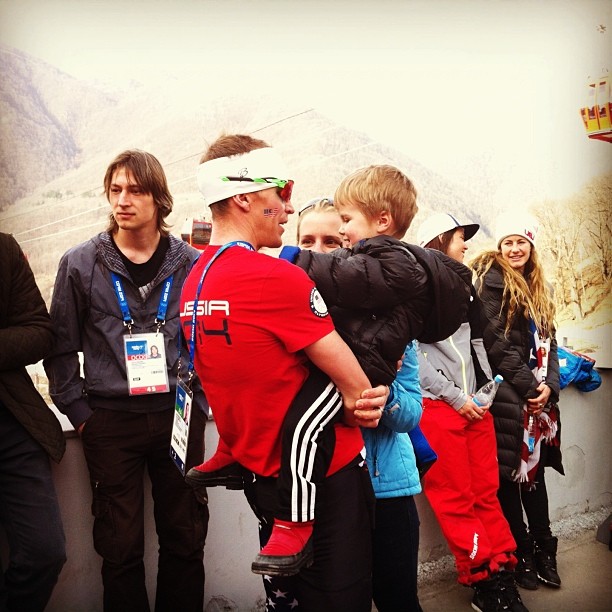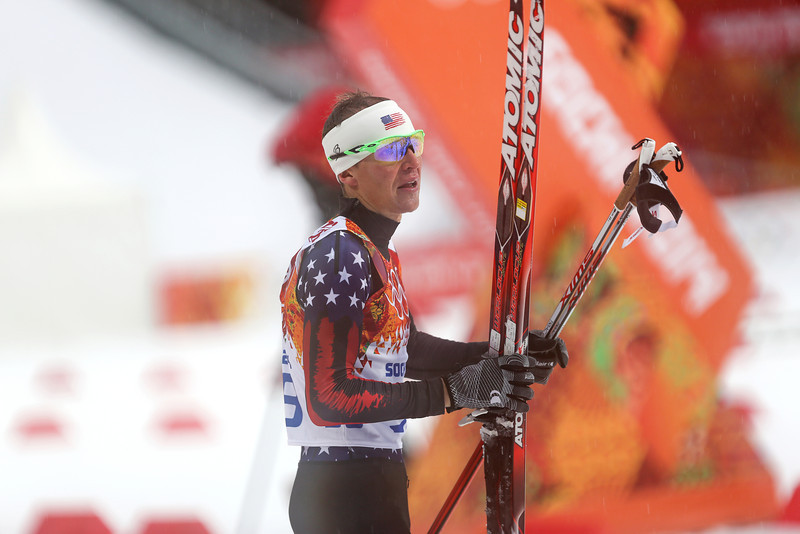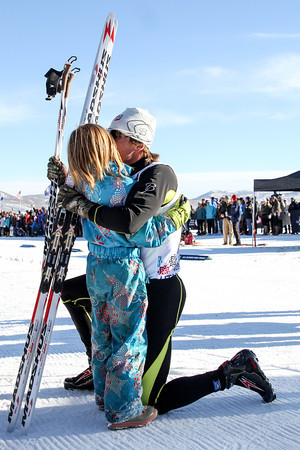
KRASNAYA POLYANA, Russia — With the clock ticking away and a competitor from the Czech Republic in hot pursuit, Billy Demong dug deep exactly a week ago in the last nordic combined race of the Olympics, trying to find any extra grit to push him across the line as the anchor leg of the 4 x 5-kilometer team event.
The U.S. Nordic Combined veteran found it, leaving him gasping for air on the ground at the finish, but when he got up, his team’s result on the video board at the RusSki Gorki Ski Jumping Center didn’t reflect the fairy tale ending many had come to expect from his team.
The Sochi Olympics hadn’t played out like the 2010 Winter Games in Vancouver, British Columbia. Not even close.
The jumps hadn’t gone well enough for the four-man U.S. Olympic team — not Thursday or in either of the two preceding individual competitions — at least not to their potential.

(Photo: Sarah Brunson/U.S. Ski Team)(Photo: Sarah Brunson/U.S. Ski Team)
Demong got some satisfaction with his best competition jump of the Sochi Games in the large-hill/4 x 5 k team event, but his score of 108 ranked seventh in his group of nine teams. Two of his teammates, Todd Lodwick and Taylor Fletcher, also ranked seventh in their groups, and Bryan Fletcher ranked ninth of the final jumpers.
Combined, the results on the hill put the U.S. in eighth, 1 minute and 52 seconds behind Germany in first. The Germans started the relay first, 7 seconds ahead of Austria. Norway followed another 25 seconds back in third, then France, the Czech Republic, Japan, and Russia, respectively.
The Americans started 38 seconds after Russia in seventh and needed to make up a minute and a half if they wanted to come close to the podium. With Demong posting the second-fastest anchor time, the team finished sixth, 2:21.6 behind the German winners and a second ahead of the Czech Republic in seventh.
“Throw the dice another day on a different jump and who knows?” Demong said after the race. “But the important thing I think as a group is that we were able to overcome any disappointment and kind of rally. Today wasn’t perfect, but I think we all enjoyed ourselves.”
A year earlier, the same team notched the first-ever U.S. relay medal at World Championships, coming back from a minute deficit in fifth to place third.
Four years ago, U.S. Nordic Combined made Olympic history with a series of unprecedented performances at the Vancouver Olympics. Johnny Spillane, who retired this past spring, opened the Games with an individual silver in the normal hill/10 k. The four-man team of Spillane, Demong, Lodwick, and Brett Camerota went on to tally another silver in the 4 x 5 k. Two days later in the individual large hill/10 k, Demong became the first U.S. nordic skier to win gold, just 4 seconds ahead of Spillane, who captured his third silver of the Games.
That is the memory that stands out for Demong, a 33-year-old, five-time Olympian, when he thinks back to the accomplishments and accompanying bliss he and his teammates experienced in Vancouver.
“Before we got whisked down to the Today Show … [Johnny and I] were sitting in room 406 or whatever … I don’t think we even had a TV in our room,” Demong told reporters after last Thursday’s 4 x 5 k. “It was pretty bleak, except we had five medals sitting on the bed, and it was kind of like, 16 years ago we were sharing the popup camper in your parents’ backyard for a summer. We did it, we’re here. It was that whole thing coming true, the dream beyond dreams.”
The Sochi Olympics didn’t repeat those memories or create new stories of success to take their place. And while Demong couldn’t put his finger on what exactly went wrong over at these Games, he wasn’t devastated by it either.
For the U.S., the team event in Sochi took on a new kind of significance, which extended beyond results for a big-picture perspective.
Lodwick, 37, who became the first six-time Winter Olympian in U.S. history, had returned to his first series of competitions since a training-jump crash in early January sent him back to the U.S. to rehab his shoulder.
The Sochi relay would be his first race back in nearly two months, and also the last of his career. For Demong, the race would most likely be his final one at the Olympics.
“I would seriously doubt that I’ll be here in four years in that capacity on skis,” Demong said.
At the same time, he didn’t rule out competing on the World Cup next season.
“As of three months ago, I was like, today’s the day, you can ship my skis to Park City or wherever, Lake Placid when this is over,” Demong recalled. “But I’m going to be back [in Europe] and I’m gonna race Trondheim and Oslo [March 6 and 8]. Part of that is to keep some options open for the team, part of it’s for myself. I think my wife and my coach Dave showed me, OK, maybe you can plan for years ahead your entire career, [but] maybe have a little grey area.”
So that’s Demong’s tentative plan — finish out the World Cup season, “take a deep breath,” then see what his team needs.
“I’m sure I’ll stay involved in the sport; I may do some racing next year,” he said. “I’m more excited and I think I owe it to the younger guys to see what they need in order to usher in the next group.”
Taylor Fletcher, a two-time Olympian and the youngest member of the A-team at 23, said it would be difficult to imagine the future without Lodwick and Demong.
“Billy and Todd and Johnny, they’re gone and honestly that sucks,” he said after skiing the fastest penultimate leg to lift the team from eighth to seventh. “Without them, it’s hard to say, but really, we’ve shown over the years that our team’s capable of putting in the hard work, getting the good results, and it’s just a matter of time.
“Hell, it might take us a decade, but we’ll get them,” Fletcher added, referring to the team’s medal drought leading up to the 2010 Olympics.
“We know what to do now. I would say last year was the year that we really figured it out. Bryan got the King’s Cup podium and that seemed like it came easy to him, and last year I got a [World Cup] podium and then we got that World Championships medal.”
The team has several development skiers that will be looked at to fill the void, including Brett Denney, who nearly made the U.S. Olympic team as the fifth-man out of its four allotted quota. While the Fletchers are the A-team’s only “sure-shot” returners, U.S. Nordic Combined has experienced B-team members in Nick Hendrickson, Adam Loomis and Michael Ward.
“Hell, it might take us a decade, but we’ll get them.” — Taylor Fletcher, on U.S. Olympic medals
“I heard several times in 2010 that nordic combined was one of the most exciting events,” Taylor said. “USA Today just rated it the hardest Olympic sport and people know what nordic combined is now, and that’s because of them [Demong, Lodwick and Spillane]. And now it’s my job, Bryan’s job and the rest of the team to kind of keep it there. … I don’t see any rhyme or reason why it won’t be where it is now and even higher. It’s just a matter of believing in ourselves and allowing it to happen.”
Demong credited team veterans like Lodwick, who won two gold medals at the 2009 World Championships after taking two years off from the sport, for raising the bar way back when.

(Photo: Sarah Brunson/U.S. Ski Team)
“Nobody does it like Todd,” Demong said. “There’s some really good lessons that I think we’ve all learned from him, a number of which are not traditional athletic lessons, but it’s about finding the right headspace. Todd can have a bad day, and he can write it off and come back out swinging”
Demong said he learned from Lodwick’s example and even put that into action in Sochi when he struggled individually, placing 31st on the large hill and 24th in the normal-hill competitions.
“If Todd hadn’t started winning World Cups as an annoying 18 year old to his older teammates, I don’t know where we’d be,” Demong said. “He certainly showed us younger guys the way, and he invested in the team … and he helped us believe that we could do it too. He’s given a lot to this sport over the years.”
Lodwick fought tears after Thursday’s race, in which he lost one place after Bryan tagged him in seventh and handed off to Taylor in eighth, 20 seconds behind Italy. It wasn’t necessarily the pain in his shoulder, which he said was improving: “It’s getting there. It’s stronger than I ever thought it would be.”
Rather, it was the fact that he was at his sixth Olympics.
“I really enjoyed getting up this morning and starting the day off right,” Lodwick said. “The Olympic rings are something that as an athlete throughout my career, you believe in them you see them in different ways. Lillehammer was the most amazing experience to that point and I really had a lot of fun. Going into Nagano, I was way too serious and I didn’t really take in the Olympic Games for what it was all about. Through the years, this being my sixth, I came here with the biggest smile. I came here just taking it in because I didn’t think I was gonna be here.”
He recalled sitting in an ambulance six weeks earlier, thinking that an Olympic comeback was out of the question.
“I remember going up to each of my teammates’ rooms and saying, please don’t count me out. They kind of looked at me like, OK, and from the first day I got back from Park City, I was on the treadmill and working my ass off to get to this point to be a team supporter. I couldn’t have gotten there without my teammates and my coaches and [team physiotherapist] Adam Perreault … he’s gotten my shoulder back the most amazing place and I cant thank him enough.”
Selected by his fellow U.S. Olympians, Lodwick went on to lead more than 200 U.S. Olympic team members as the Opening Ceremony flag bearer on Feb. 7. The next week, he returned to competition for the first time since December and logged half a dozen training jumps in Sochi — the first since his accident.
Lodwick jumped to 34th on the 106-meter normal hill on Feb. 12, the second-best result after Demong in 31st, then ranked 30th on the 140-meter large hill on Feb. 18. He did not race either days in an effort to let his shoulder heal as much as possible before the team event on Feb. 20.
There, Lodwick’s jump was the second-best after Demong’s. He started his first race in nearly a month as the U.S. team’s second leg, taking over after Bryan made up more than 50 seconds on the teams ahead of him.
“You start, the gun goes off and you race, you get tagged and you race,” Lodwick recalled. “I proved probably more to myself than I did to anybody else, that with hard work and a lot of support that anything is possible. First step is to dream big. That’s something that I live by. Anything is possible and I wouldn’t do anything different. The shoulder injury was a blessing. It made me respect this sport and the hard work to getting back, these Olympic Games, just taking everything in.”
Lodwick reflected on how each Olympic experience was different, and how he’s grown over the last two decades in the sport.
“Lillehammer [in 1994] was the most amazing experience to that point and I really had a lot of fun,” he said. “Going into Nagano [in ’98], I was way too serious and I didn’t really take in the Olympic Games for what it was all about. Through the years, this being my sixth, I came here with the biggest smile. I came here just taking it in because I didn’t think I was gonna be here.”
He guaranteed himself a spot by winning the U.S. Olympic Trials on Dec. 28. Less than two weeks later, he crashed in Chaux-Neuve, France, just four weeks out from the Sochi Games.
While Lodwick soaked up the moment in the mixed zone with reporters, looking up at times with tears in his eyes, Demong caught a glimpse of his wife holding their 3-year-old son, and took an early exit to meet them on the other side of the fence.
“Liam!” Demong exclaimed.
“Daddy!” Liam called out.
Four years ago, Demong proposed to Katie after winning gold in Vancouver, then was chosen to carry the U.S. flag in the Closing Ceremony. In Sochi, his personal journey had come full circle; he had both Katie and his first child cheering him on.
Alex Kochon
Alex Kochon (alexkochon@gmail.com) is a former FasterSkier editor and roving reporter who never really lost touch with the nordic scene. A freelance writer, editor, and outdoor-loving mom of two, she lives in northeastern New York and enjoys adventuring in the Adirondacks. She shares her passion for sports and recreation as the co-founder of "Ride On! Mountain Bike Trail Guide" and a sales and content contributor at Curated.com. When she's not skiing or chasing her kids around, Alex assists authors as a production and marketing coordinator for iPub Global Connection.




One comment
nyctvt
February 27, 2014 at 9:19 am
The US Nordic Combined Team is a class act.